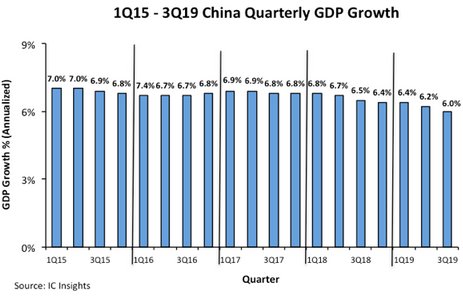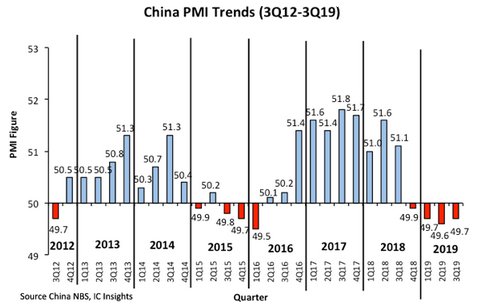中国国内生产总值(GDP)和制造业采购经理指数(PMI)收缩是全球经济的风险因素
Potential that China’s economy will break sharply to the downside from its current gradual downward slope.
October 29, 2019 -- IC Insights recently released its October Update to The McClean Report 2019. Part of the update reviewed U.S. and China GDP and PMI trends in light of the current trade friction between the two nations.
Given that the global economy increased by a healthy 3.0% in 2018, it is difficult to comprehend that an economy growing 6% could be considered a risk factor for worldwide GDP growth this year. However, that is the case with China and it’s slowing economic growth. Of concern is that China’s quarterly economic growth rate will break sharply to the downside from its current gradual downward slope (Figure 1).

Figure 1
China’s 2017 GDP was 6.9% and it registered a slightly lower 6.6% in 2018. IC Insights forecasts further slowing in China’s GDP growth rate to 6.1% this year (the latest IMF forecast released this month also calls for 6.1% growth this year while the World Bank forecast is for China’s economy to register a 6.2% increase in 2019). Moreover, the World Bank in May of 2019 stated that its 2020 forecast for China’s GDP growth rate is 6.1% while the October-2019-released IMF forecast for China’s GDP growth rate in 2020 is 5.8%. It is interesting to note that China’s quarterly GDP growth rate has ranged between 6.0% and 7.0% for almost five years.
Although most economists, and IC Insights, believe that China’s economic growth will continue down its soft landing path over the next few years, there is concern about a possible hard landing for the Chinese economy due to the potential bursting of its over-inflated property market, the impact of stock market volatility on Chinese consumer’s attitudes, or an abrupt slowdown in growth for its exports due to the trade war.
A hard landing for China’s economy in the near future would be loosely defined as annual GDP growth of less than 6.0% this year or less than 5.5% 2020. The Chinese government estimates that China needs to add about eight million new jobs a year to sustain a GDP growth rate of near 6.0%, a task that is increasingly difficult to accomplish.
Figure 2 depicts China’s PMI trends from 3Q12 through 3Q19. Since 3Q12, China’s PMI has remained in a narrow 2.3 point bandwidth (49.5-51.8).
In 2017, China’s PMI figures came in above 51.0 in every quarter, a result that was last seen in 2010. Although China’s PMI figures were ≥51.0 during the first three quarters of 2018, the country’s PMI number dropped below 50.0—the demarcation line between growth and contraction—to 49.9 in 4Q18 and remained below 50.0 for the first three quarters of this year. Moreover, China’s quarterly PMI has been below 50 ever since the U.S. implemented the first round of tariffs on Chinese exports in 3Q18.
Overall, the low level of China’s PMI figures, as well as concerns about the possible continuation of the current trade war, have created a significant amount of anxiety over the health of the Chinese economy in the fourth quarter of 2019. Without a trade deal between the U.S. and China, this index is likely to stay below 50 as the worldwide economy continues to slow.

Figure 2
Report Details: The McClean Report 2019
Additional details on the global economy and its impact on the IC market are provided in The McClean Report—A Complete Analysis and Forecast of the Integrated Circuit Industry. A subscription to The McClean Report includes free monthly updates from March through November (including the 200+ page Mid-Year Update), and free access to subscriber-only webinars throughout the year. An individual user license to The McClean Report is priced at $4,990 and includes an Internet access password. A multi-user worldwide corporate license is available for $7,990.
Related Semiconductor IP
- Ultra-Low-Power LPDDR3/LPDDR2/DDR3L Combo Subsystem
- 1G BASE-T Ethernet Verification IP
- Network-on-Chip (NoC)
- Microsecond Channel (MSC/MSC-Plus) Controller
- 12-bit, 400 MSPS SAR ADC - TSMC 12nm FFC
Related News
- 中国是唯一在2019年实现纯晶圆代工销售增长的国家
- 高通与贵州省签署战略合作协议,并组建合资企业以在中国研发和销售服务器芯片
- 为什么AMD应该在中国建立ARM架构生态系统和市场
- Cadence工具获台积电7纳米早期设计及10纳米芯片生产认证